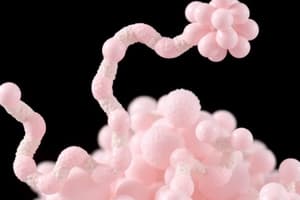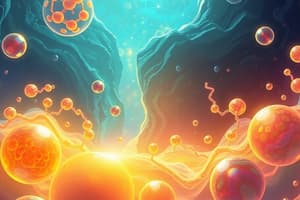Podcast
Questions and Answers
Which enzyme is specifically used as an indicator in the coupled enzymatic reaction involving lactate dehydrogenase?
Which enzyme is specifically used as an indicator in the coupled enzymatic reaction involving lactate dehydrogenase?
- Creatine kinase
- NADH (correct)
- Aspartate aminotransferase
- Alkaline phosphatase
What does an elevated level of lactate dehydrogenase (LDH) typically indicate?
What does an elevated level of lactate dehydrogenase (LDH) typically indicate?
- Improved liver function
- Normal metabolic activity
- Increased muscle strength
- Tissue damage or disease (correct)
What is the reference range for LDH activity at a temperature of 37°C?
What is the reference range for LDH activity at a temperature of 37°C?
- 100-150 U/L
- 5-20 U/L
- 7-45 U/L (correct)
- 200-250 U/L
What is a common source of error when measuring LDH levels?
What is a common source of error when measuring LDH levels?
What is a primary clinical significance of amylase?
What is a primary clinical significance of amylase?
Which of the following disorders can be indicated by elevated LDH levels?
Which of the following disorders can be indicated by elevated LDH levels?
Which condition is associated with abnormal acid phosphatase levels?
Which condition is associated with abnormal acid phosphatase levels?
Which of the following is NOT a consequence of hemolysis in clinical testing?
Which of the following is NOT a consequence of hemolysis in clinical testing?
What is the reference range for serum amylase activity?
What is the reference range for serum amylase activity?
Which methodology is used for enzyme activity assays mentioned in the content?
Which methodology is used for enzyme activity assays mentioned in the content?
Which of these diseases is associated with skeletal muscle disorders?
Which of these diseases is associated with skeletal muscle disorders?
What effect does a high-fat meal have on enzyme tests?
What effect does a high-fat meal have on enzyme tests?
Which clinical significance is NOT associated with hepatocellular disorders?
Which clinical significance is NOT associated with hepatocellular disorders?
What is the primary function of creatine kinase (CK)?
What is the primary function of creatine kinase (CK)?
Which of the following can act as a cofactor for enzymatic reactions?
Which of the following can act as a cofactor for enzymatic reactions?
What happens to enzyme activity as temperature increases?
What happens to enzyme activity as temperature increases?
What is the significance of elevated CK-MB levels?
What is the significance of elevated CK-MB levels?
What can inhibit enzymatic reactions?
What can inhibit enzymatic reactions?
Which enzyme catalyzes the transfer of an amino group from alanine?
Which enzyme catalyzes the transfer of an amino group from alanine?
What is the typical reference range for creatine kinase levels in females?
What is the typical reference range for creatine kinase levels in females?
What substance is used as a cofactor by lactate dehydrogenase (LDH)?
What substance is used as a cofactor by lactate dehydrogenase (LDH)?
What is the primary role of enzymes in biochemical reactions?
What is the primary role of enzymes in biochemical reactions?
Which enzyme class is responsible for the transfer of a chemical group other than hydrogen from one substrate to another?
Which enzyme class is responsible for the transfer of a chemical group other than hydrogen from one substrate to another?
What defines the tertiary structure of an enzyme?
What defines the tertiary structure of an enzyme?
Which of the following statements about isozymes is correct?
Which of the following statements about isozymes is correct?
Which enzyme class is involved in splitting a bond through hydrolysis?
Which enzyme class is involved in splitting a bond through hydrolysis?
What is the role of cofactors in enzymatic activity?
What is the role of cofactors in enzymatic activity?
Which structure refers to the spatial arrangement of more than one polypeptide unit in an enzyme?
Which structure refers to the spatial arrangement of more than one polypeptide unit in an enzyme?
What distinguishes ligases from other enzyme classes?
What distinguishes ligases from other enzyme classes?
What is the primary role of activators in enzyme kinetics?
What is the primary role of activators in enzyme kinetics?
Which type of inhibitor binds exclusively to the enzyme-substrate complex?
Which type of inhibitor binds exclusively to the enzyme-substrate complex?
What determines an enzyme's specificity towards a substrate?
What determines an enzyme's specificity towards a substrate?
Which factor does NOT affect enzymatic reactions?
Which factor does NOT affect enzymatic reactions?
What is an absolute enzyme specificity?
What is an absolute enzyme specificity?
How does substrate concentration influence reaction rates?
How does substrate concentration influence reaction rates?
Which pH range is typically considered optimal for most enzymes?
Which pH range is typically considered optimal for most enzymes?
What effect do non-competitive inhibitors have on enzyme activity?
What effect do non-competitive inhibitors have on enzyme activity?
Study Notes
Enzymology Overview
- Enzymes are specific biological proteins that catalyze biochemical reactions without altering equilibrium.
- Present in all body tissues, especially serum post cellular injury.
Enzyme Classification
- Oxidoreductases: Catalyze removal/addition of electrons (redox reactions).
- Transferases: Transfer chemical groups (other than hydrogen) between substrates.
- Hydrolases: Split bonds by adding water (hydrolytic reactions).
- Lyases: Remove groups from substrates without hydrolysis, forming double bonds.
- Isomerases: Catalyze reorganization of molecular structures.
- Ligases: Join two molecules with covalent bonds.
Enzyme Structure
- Primary Structure: Sequence of amino acids.
- Secondary Structure: Twisting of polypeptide chains.
- Tertiary Structure: Folding due to structural cavities.
- Quaternary Structure: Arrangement of multiple polypeptide units.
Isoenzymes and Isoforms
- Isoenzymes: Different forms of an enzyme catalyzing the same reaction.
- Isoforms: Variants due to post-translational modifications.
Enzyme Activity Components
- Cofactors: Non-protein molecules essential for enzyme function.
- Activators: Inorganic cofactors (e.g., Ca, Mg, Zn) enhancing enzyme activity.
- Coenzymes: Organic cofactors, for example, NAD.
Enzyme Kinetics
- Enzymes reduce activation energy required for biochemical reactions.
- Reaction velocity relates to substrate concentration according to Michaelis-Menten kinetics.
Types of Inhibitors
- Competitive Inhibitors: Compete with substrate for active site.
- Non-competitive Inhibitors: Bind to an alternative site affecting enzyme function.
- Uncompetitive Inhibitors: Bind only to the enzyme-substrate complex.
Factors Influencing Enzyme Reactions
- Substrate Concentration: High levels can cause denaturation.
- Enzyme Concentration: Affects reaction rate until saturation.
- pH: Optimum 7.0-8.0; deviations cause denaturation.
- Temperature: Higher temperatures increase reaction rates but can lead to denaturation.
Clinical Significance of Enzymes
- Elevated enzyme levels often indicate tissue damage or disease.
- Specific enzymes assist in diagnosing conditions such as myocardial infarction and liver diseases.
Key Enzymes and Their Clinical Significance
-
Creatine Kinase (CK):
- Found primarily in muscle tissue, heart, and brain.
- Elevated levels significant for myocardial infarction.
-
Lactate Dehydrogenase (LDH):
- Catalyzes lactate to pyruvate interconversion.
- Clinical indicator of tissue damage or disease across various organs.
-
Aspartate Aminotransferase (AST):
- Involves the transfer of amino groups, primarily found in liver and heart.
- Elevated in liver and skeletal muscle disorders.
-
Alkaline Phosphatase (ALP):
- Involved in hydrolysis of phosphate esters.
- Clinical significance in liver and bone diseases.
-
Amylase:
- Hydrolyzes starch and glycogen into simple sugars.
Assay for Enzyme Activity
- Employ various methodologies for accurately measuring enzyme levels.
- Certain enzymes stable for several days post-collection under refrigeration; hemolysis affects results.
Reference Ranges
- CK: Male 46-171 U/L; Female 34-145 U/L at 37°C.
- LDH: 125-220 U/L at 37°C.
- AST: 5-35 U/L at 37°C.
- ALP: 42-128 U/L at 30°C for ages 20-50 years.
Use these key points for a comprehensive understanding of enzymatic functions, behaviors, and clinical implications in medical settings.
Studying That Suits You
Use AI to generate personalized quizzes and flashcards to suit your learning preferences.
Related Documents
Description
Dive into the fascinating world of enzymes with this quiz. Explore key concepts such as enzyme classification, structure, and the significance of isoenzymes. Assess your understanding of how these biological catalysts function and their roles in biochemical reactions.




